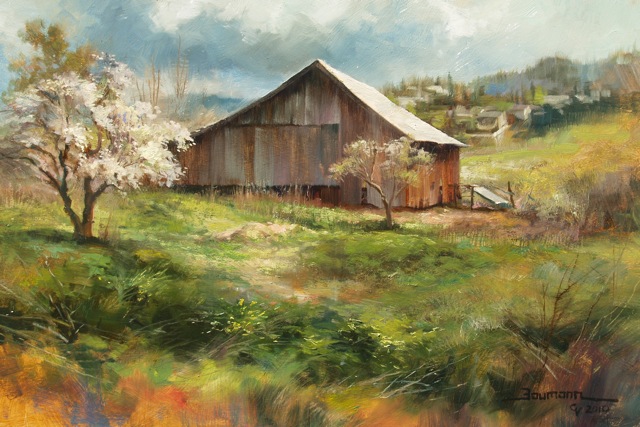“Ashland Barn” by Stefan Baumann
Last week I was traveling in Medford, Oregon, prepared to paint with my brushes, paints, and canvases in my truck, when I took an unexpected turn off the freeway onto a quiet country road. It had been raining and a magnificent cloud formation with impressive effects of light covered the sky. I drove by an old pear orchard, and noticed a beautiful pear tree covered with blossoms that had an old barn as a backdrop. As I came closer to the tree, the sky opened and a beam of sunlight lit up the metal roof on the barn creating a dramatic moment of contrasting lights and darks. I pulled over quickly, gathered my painting supplies, and began mixing my foundation color. An artist must always be prepared to paint when inspiration strikes. A writer has sharp pencils and paper in a shirt pocket to jot down notes. A cook always has a collection of spices in his kitchen ready to create the next culinary extravaganza. The artist must have supplies at hand to be able to catch the moment of inspiration and transfer it to canvas. A travel bag outfitted with these basic essentials will serve you well whenever you want to create: red, yellow, and blue paint, a palette, canvas, brushes, turpentine, and paper towels. Like a good scout, it pays to be prepared for anything.
Being prepared to paint does not take the work and discomfort out of painting on location. If we remembered all the obstacles we may encounter outdoors, such as the weather, changing light, difficulties with sketching and composition, inhospitable insects, and changing temperatures, we would probably talk ourselves out of it and never do it again. If you boldly go where so many would never go, be kind to yourself. Have reasonable expectations of what you can accomplish. Give yourself applause for venturing outdoors to try your best to paint what you see and love. You can always wipe it off after you give your best effort. Or you can remember that painting, as in any art, requires practice to learn how to do it. Without the struggle, successes would not be as valuable and exciting.
What stops you from painting? Sometimes artists worry about not painting “good enough,” negatively compare themselves with others and feel inferior, or are embarrassed or ashamed because they cannot paint the masterpiece that they dream of creating. Knowledge comes from practicing and making mistakes, as awkward and frustrating as it is, and artists must be willing to make 100 mistakes on their canvases before they can begin to know how to paint well. Try not to judge your success by the finished piece. The experience that happens in your imagination as you paint is what counts. As you intentionally practice the discipline of painting, remember also to enjoy the pleasure of painting by exploring the possibilities of what you can do with color, shapes, composition, and light. At the end of the day, sharing your imagination, feelings, and experiences through art is worthy and important as a way of communicating and connecting person to person.
_________________________________________________________________________________
Plein air and Alla Prima artist Stefan Baumann, host of the PBS painting series “The Grand View, America’s National Park through the eyes of an artist” and author of “Observations Of Art and Nature,” travels in his vintage travel trailer painting America’s western landscape. Baumann paints outdoors with oils and canvas, capturing stunning vistas, wildlife, western landscapes, National Parks and still life, thrilling art collectors throughout the world. He has many international collectors acquiring his paintings as investments. His painting style is called Romantic Realism with Luminism, and the extraordinary way he captures the effect of light is a truly an American style used to paint the Western landscape. He can be seen painting in Yellowstone, Yosemite and Grand Canyon National Parks. Baumann’s “how to paint” DVDs, filmed on location in the National Parks, are the very best on the art instruction market.

